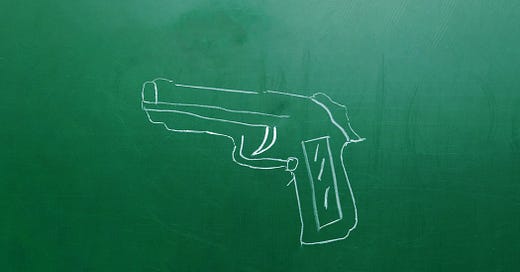
Stop Calling School Shootings ‘Unimaginable’
This is an epidemic, not a series of unique tragedies.
OF ALL THE REFLECTIONS offered by lawmakers on the school shooting that left four people dead at Apalachee High School this week, one from Sen. Rick Scott stood out.
“Our hearts break for the families of two students and two teachers in Winder, Georgia, who suffered an unimaginable loss today because of a deranged monster,” said the Florida Republican.
The senator’s heart may have been in the right place. But his words were wrong. There’s nothing “unimaginable” about what happened. It happens all the time.
Six-and-a-half years ago, seventeen people were killed in the Marjory Stoneman Douglas High School shooting in Scott’s home state. Last year, three students and three staff members were killed in a shooting at the Covenant School in the Green Hills neighborhood in Tennessee. The 2023 Michigan State University shooting saw a man kill three and wound five before killing himself. The shooting in Uvalde, in May 2022, saw nineteen students and two teachers lose their lives. The 2021 Oxford High School shooting saw four students killed and seven others wounded. The May 2018 Santa Fe High School shooting resulted in ten deaths and thirteen injuries.
These are just the headline grabbers from the past few years. A database compiled by the gun control group Everytown for Gun Safety records 139 incidents of gunfire on school grounds (different from school shootings) just this year, resulting in 42 deaths and 93 injuries. Just since August 1, according to an official with the group, there have been thirteen such incidents.
It’s useful to bring up these numbers in the wake of the Apalachee High School shooting to remind people that while these are devastating events, they are not extraordinary ones. This is not a series of unique tragedies but an epidemic. We shouldn’t treat it as otherworldly or unimaginable because it’s not.
On Thursday, JD Vance described the shooting in Winder as an unfortunate “fact of life.” To a degree, the crux of what Vance said is true. School shootings are our grim, decidedly American reality.
But recognizing that reality is different than accepting it. And Vance’s suggestion that the only possible response is to fortify our schools and get used to the dystopia was not just defeatist and cynical; it ignored the fact we’ve already taken many of those steps. The bipartisan gun safety bill that Biden signed allocated billions of dollars to prevent school violence.
It’s back-to-school time. Parents I talked to this week reported that their kids see active shooter drills as just another part of the curriculum; a ghastly update to their own generation's “stop, drop, and roll” fire safety protocol. Teachers I talked to explained how classrooms can be transformed into mini-fortresses. Administrators have spoken about a renewed focus on mental health services, after-school programs, and evidence-based community violence interventions.
Even the free market has adapted. One official who works in the bulletproof backpack industry told me that business had grown “dramatically” over the last four years.
“Ninety percent are parents buying for their kids. I’ve had parents calling me saying their high school kid is begging to get one. Mostly, it’s for peace of mind,” he explained, speaking on condition of anonymity for fear of social backlash. “It’s sickening that we are here because of that.”
Is more fortification possible? Perhaps. But is the idea to turn our schools into maximum-security facilities with some whiteboards and books? At Apalachee High, Georgia authorities touted the fact that the school resource officers were able to effectively respond to the scene and limit the damage precisely because they had “extensive backgrounds in school threat training.”
Four people still died.
To treat school shootings as either unimaginable events or failures of school fortification also elides how much of the damage they cause is outside the school, and how it lingers far longer than the media’s gaze.
It’s measured in families torn apart, devastated communities, and psychic shock. Fred Guttenberg, whose daughter Jaime died in Parkland, told me once about the toll that day took on her brother, who had called him amid the shooting, begging for his permission to turn around and look for his sister.
“I remember the bullets on the phone,” Fred recalled.
“My son looked after Jamie like a hawk. He would have given up his life for her. To this day, he doesn’t understand why it was his sister. He just really thought of himself as her protector,” he said. “They were typical siblings with the typical sibling garbage. But they loved each other. He genuinely was wanting me to say it’s ok to turn around and go back. But I wouldn’t do it. He struggles with that every day.”
“We always get caught up on how many people died,” he added. “It is so much bigger than that.”
For Fred and so many others, the issue of school shootings is not about the school. It’s about the individuals, both victims and perpetrators. And, of course, it’s about guns. No matter how fortified the classroom or the backpack, there will be tragedies as long as troubled kids have easy access to lethal firearms (in the case of Apalachee, gifted by a father even after law enforcement raised concerns about his son with him).
But even as stricter gun laws seem like the obvious solution to a majority of Americans, a minority still firmly resists. Vance is content to treat school shootings as a chronic disease that we must reconcile ourselves to living with, not one we are frantically trying to cure. Scott is comfortable talking about these incidents as uniquely tragic blips that we can’t possibly process.
We are expected to express our sorrow, mourn for the dead, shrug our shoulders, and move on. In the end, what becomes unimaginable is not the tragedy itself but our capacity to prevent the next one.
















